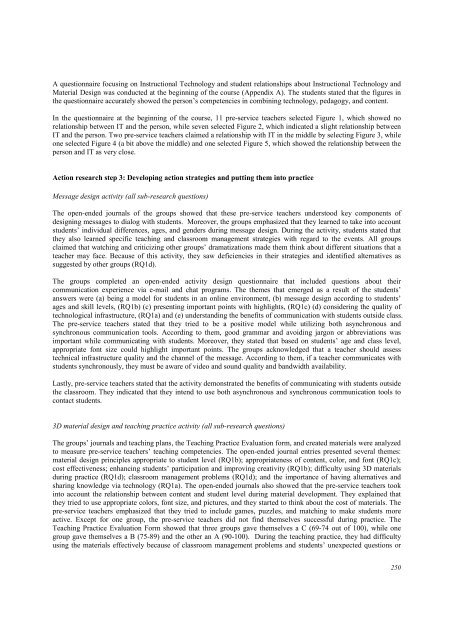Download Complete Issue in PDF - Educational Technology & Society
Download Complete Issue in PDF - Educational Technology & Society
Download Complete Issue in PDF - Educational Technology & Society
You also want an ePaper? Increase the reach of your titles
YUMPU automatically turns print PDFs into web optimized ePapers that Google loves.
A questionnaire focus<strong>in</strong>g on Instructional <strong>Technology</strong> and student relationships about Instructional <strong>Technology</strong> and<br />
Material Design was conducted at the beg<strong>in</strong>n<strong>in</strong>g of the course (Appendix A). The students stated that the figures <strong>in</strong><br />
the questionnaire accurately showed the person’s competencies <strong>in</strong> comb<strong>in</strong><strong>in</strong>g technology, pedagogy, and content.<br />
In the questionnaire at the beg<strong>in</strong>n<strong>in</strong>g of the course, 11 pre-service teachers selected Figure 1, which showed no<br />
relationship between IT and the person, while seven selected Figure 2, which <strong>in</strong>dicated a slight relationship between<br />
IT and the person. Two pre-service teachers claimed a relationship with IT <strong>in</strong> the middle by select<strong>in</strong>g Figure 3, while<br />
one selected Figure 4 (a bit above the middle) and one selected Figure 5, which showed the relationship between the<br />
person and IT as very close.<br />
Action research step 3: Develop<strong>in</strong>g action strategies and putt<strong>in</strong>g them <strong>in</strong>to practice<br />
Message design activity (all sub-research questions)<br />
The open-ended journals of the groups showed that these pre-service teachers understood key components of<br />
design<strong>in</strong>g messages to dialog with students. Moreover, the groups emphasized that they learned to take <strong>in</strong>to account<br />
students’ <strong>in</strong>dividual differences, ages, and genders dur<strong>in</strong>g message design. Dur<strong>in</strong>g the activity, students stated that<br />
they also learned specific teach<strong>in</strong>g and classroom management strategies with regard to the events. All groups<br />
claimed that watch<strong>in</strong>g and criticiz<strong>in</strong>g other groups’ dramatizations made them th<strong>in</strong>k about different situations that a<br />
teacher may face. Because of this activity, they saw deficiencies <strong>in</strong> their strategies and identified alternatives as<br />
suggested by other groups (RQ1d).<br />
The groups completed an open-ended activity design questionnaire that <strong>in</strong>cluded questions about their<br />
communication experience via e-mail and chat programs. The themes that emerged as a result of the students’<br />
answers were (a) be<strong>in</strong>g a model for students <strong>in</strong> an onl<strong>in</strong>e environment, (b) message design accord<strong>in</strong>g to students’<br />
ages and skill levels, (RQ1b) (c) present<strong>in</strong>g important po<strong>in</strong>ts with highlights, (RQ1c) (d) consider<strong>in</strong>g the quality of<br />
technological <strong>in</strong>frastructure, (RQ1a) and (e) understand<strong>in</strong>g the benefits of communication with students outside class.<br />
The pre-service teachers stated that they tried to be a positive model while utiliz<strong>in</strong>g both asynchronous and<br />
synchronous communication tools. Accord<strong>in</strong>g to them, good grammar and avoid<strong>in</strong>g jargon or abbreviations was<br />
important while communicat<strong>in</strong>g with students. Moreover, they stated that based on students’ age and class level,<br />
appropriate font size could highlight important po<strong>in</strong>ts. The groups acknowledged that a teacher should assess<br />
technical <strong>in</strong>frastructure quality and the channel of the message. Accord<strong>in</strong>g to them, if a teacher communicates with<br />
students synchronously, they must be aware of video and sound quality and bandwidth availability.<br />
Lastly, pre-service teachers stated that the activity demonstrated the benefits of communicat<strong>in</strong>g with students outside<br />
the classroom. They <strong>in</strong>dicated that they <strong>in</strong>tend to use both asynchronous and synchronous communication tools to<br />
contact students.<br />
3D material design and teach<strong>in</strong>g practice activity (all sub-research questions)<br />
The groups’ journals and teach<strong>in</strong>g plans, the Teach<strong>in</strong>g Practice Evaluation form, and created materials were analyzed<br />
to measure pre-service teachers’ teach<strong>in</strong>g competencies. The open-ended journal entries presented several themes:<br />
material design pr<strong>in</strong>ciples appropriate to student level (RQ1b); appropriateness of content, color, and font (RQ1c);<br />
cost effectiveness; enhanc<strong>in</strong>g students’ participation and improv<strong>in</strong>g creativity (RQ1b); difficulty us<strong>in</strong>g 3D materials<br />
dur<strong>in</strong>g practice (RQ1d); classroom management problems (RQ1d); and the importance of hav<strong>in</strong>g alternatives and<br />
shar<strong>in</strong>g knowledge via technology (RQ1a). The open-ended journals also showed that the pre-service teachers took<br />
<strong>in</strong>to account the relationship between content and student level dur<strong>in</strong>g material development. They expla<strong>in</strong>ed that<br />
they tried to use appropriate colors, font size, and pictures, and they started to th<strong>in</strong>k about the cost of materials. The<br />
pre-service teachers emphasized that they tried to <strong>in</strong>clude games, puzzles, and match<strong>in</strong>g to make students more<br />
active. Except for one group, the pre-service teachers did not f<strong>in</strong>d themselves successful dur<strong>in</strong>g practice. The<br />
Teach<strong>in</strong>g Practice Evaluation Form showed that three groups gave themselves a C (69-74 out of 100), while one<br />
group gave themselves a B (75-89) and the other an A (90-100). Dur<strong>in</strong>g the teach<strong>in</strong>g practice, they had difficulty<br />
us<strong>in</strong>g the materials effectively because of classroom management problems and students’ unexpected questions or<br />
250

















